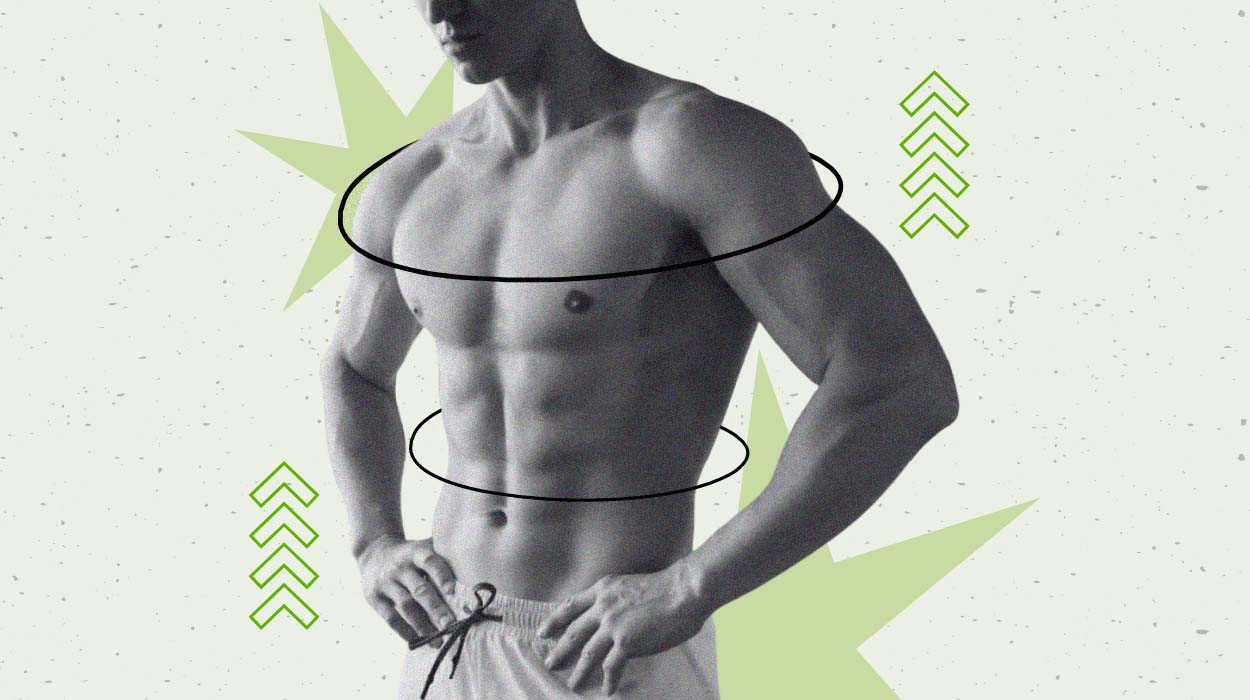
The chest and abs are two areas many of us dream of perfecting. Luckily, several exercises in a chest and ab workout help activate both muscles at the same time. These help you look good and deliver great functional strength and stability. Plus, these exercises help you save time, too!
We’ll break down seven of the best chest and ab exercises, explain their benefits, and then guide you through the steps to perform them correctly and safely. Whether your goal is building muscle, weight loss, or toning up, these exercises can add greatly to your routine. Used alongside proper diet and, if necessary, supplements, such as protein shakes or fat burners, you’ll be well on your way!
Ab And Chest Workout For Muscle-Building
Best Chest And Ab Workout For Bodybuilders
These seven muscle-building exercises work your chest and core muscles simultaneously. The first five are suitable for all skill levels. The last two should only be attempted when you have built up your experience, core strength, and skill level.
Push-Up With Knee Tuck
This abs combo workout targets the chest by using your body weight with a push-up and abdominal work with a knee tuck. It not only strengthens your upper body, promoting chest and shoulder definition but also enhances core stability and abdominal strength.
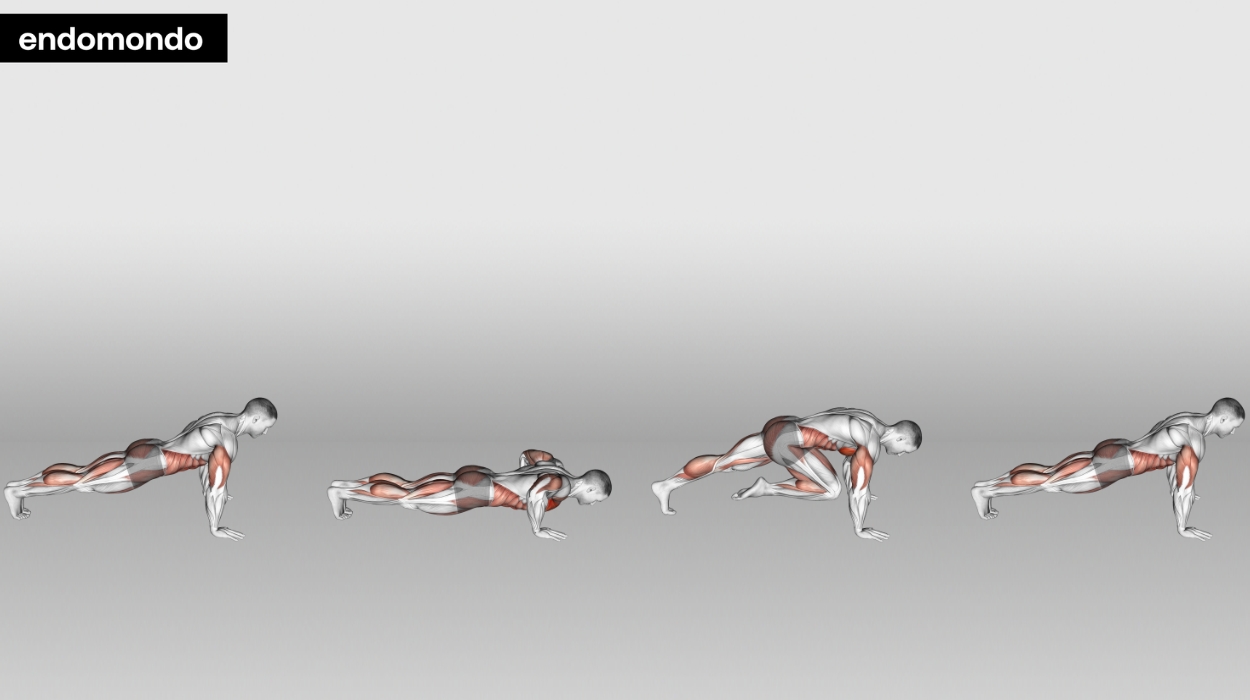
How to do:
- Start in a high plank position.
- Perform a standard push-up, then draw one knee toward your chest.
- Extend the leg back out, perform another push-up, and then draw the other knee in.
Tips:
- Maintain a strong plank position throughout the exercise, with your hands under your shoulders and your body in a straight line from head to heels.
- Avoid jerky motions and focus on using your core to tuck your knees in towards your chest.
- Remember to breathe regularly and maintain a steady pace.
Optimal Sets and Reps: 2-4 sets of 8-12 reps.
Barbell Pullover
The barbell pullover is a versatile exercise that primarily targets the chest and lats while also engaging the triceps and shoulders. This exercise aids in sculpting and strengthening the chest and lats, enhancing upper body definition. Additionally, it promotes core engagement, contributing to improved core stability and abdominal strength.
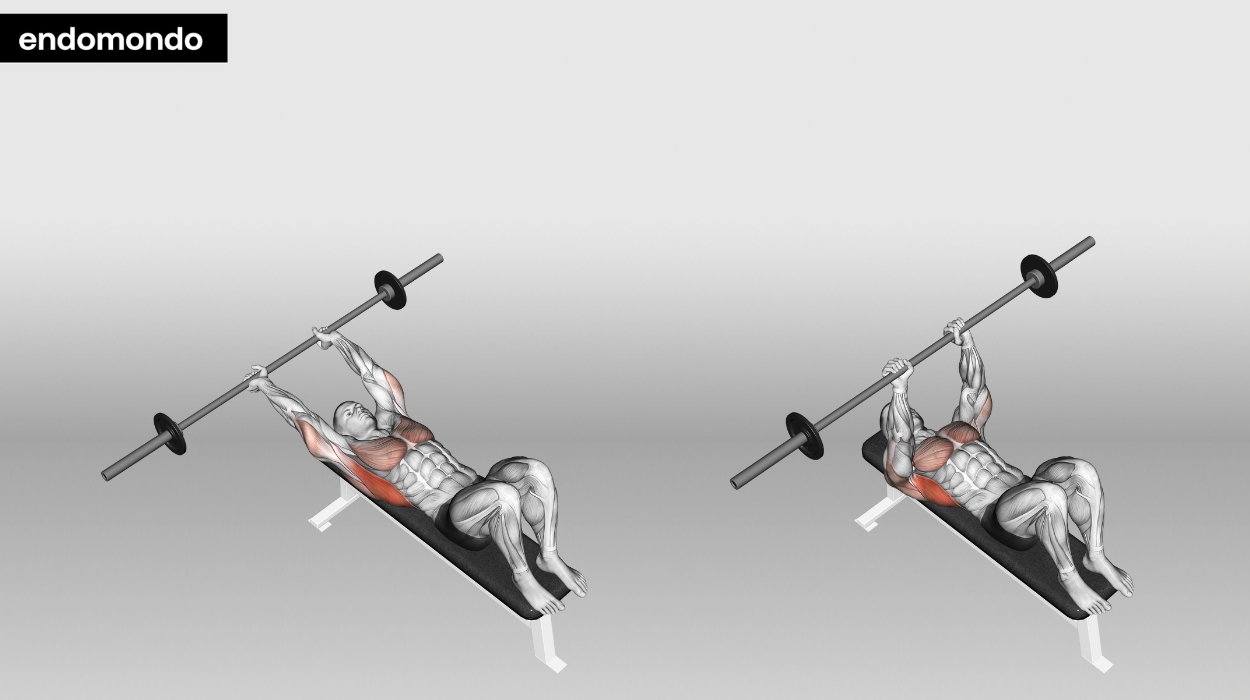
How to do:
- For your starting position, lie on a bench with a barbell held high above your chest, with your arms stretched out in a straight line toward the ceiling.
- Your arms should be at a 90-degree angle from your body.
- Start with a weight you can comfortably handle until you’re comfortable with the movement and coordination.
- Slowly lower the barbell back over your head, keeping your triceps straight up while bending at the elbow to lower your forearms back.
- Then, use your chest and ab muscles to pull the bar back to the starting position.
Tips:
- Keep a slight bend in your elbows throughout the movement for better control.
- Maintain control as you lift the barbell back to the starting position, focusing on the stretch and contraction in your chest and lats.
- Do not allow your lower back to lift off the bench, as this can strain your back.
Optimal Sets and Reps: 2-3 sets of 8-10 reps.
Dumbbell Fly With Leg Raise
The dumbbell fly with leg raise is a compound exercise that primarily targets the chest muscles while engaging the abdominal muscles. It helps sculpt and strengthen the chest, promoting chest definition. Simultaneously, the leg raise engages the lower abdominal muscles, contributing to core stability and strengthening.
How to do:
- Begin by lying flat on your back on a bench or mat.
- Hold a dumbbell in each hand. Extend your arms to your sides in line with your shoulders, but keep your elbows slightly bent. This is the starting position for the dumbbell fly.
- Simultaneously, raise the dumbbells in a wide arc above your chest until they meet directly above your chest. Be sure to maintain a slight bend at the elbows to prevent strain.
- While you bring the dumbbells together, raise your legs simultaneously until they are at a 90-degree angle from the floor.
- Keep your knees bent slightly or straight. Depending on your flexibility.
- Lower your arms and legs back to the starting position simultaneously.
- Do this in a controlled manner — don’t just let gravity do the work. Remember to keep the same slight bend in your elbows as you lower the weights.
Tips:
- Keep your leg raises controlled and avoid using momentum, focusing on engaging your chest and core muscles.
- Maintain a steady tempo throughout the exercise, controlling both the chest fly and leg raise motions.
- Coordinate your breath with the movements to help maintain stability and control.
Optimal Sets and Reps: 2-3 sets of 10-15 reps.
Medicine Ball Slam
The medicine ball slam is an explosive exercise that primarily targets the chest, shoulders, and core muscles. The exercise enhances chest and shoulder strength while promoting explosive power, which can be valuable for sports and functional fitness.
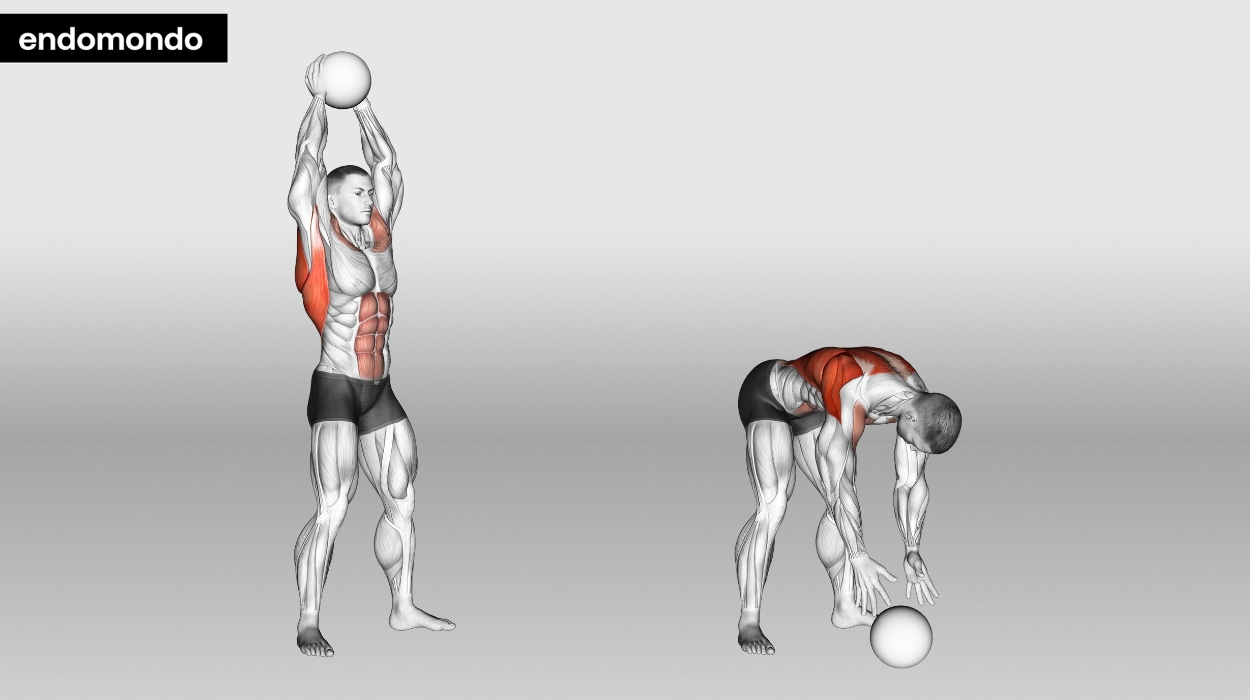
How to do:
- Stand with feet shoulder-width apart, with a medicine ball in your hands.
- Lift the ball overhead while rising onto the balls of your feet.
- Slam the ball onto the ground as you squat down, engaging your core.
Tips:
- Use your legs, hips, and core together with your arms to generate power for the slam.
- Avoid overextension of your arms or lower back as you slam the medicine ball.
- Exhale forcefully as you slam the ball down and inhale as you prepare for the next repetition.
Optimal Sets and Reps: 3 sets of 8-10 reps.
Spiderman Push-Up
The Spiderman push-up is a challenging variation of the traditional push-up that primarily targets the chest, shoulders, and triceps while intensively engaging the abdominal and oblique muscles.
This chest and core workout not only strengthens the upper body, promoting chest and shoulder definition but also enhances core stability and abdominal strength.
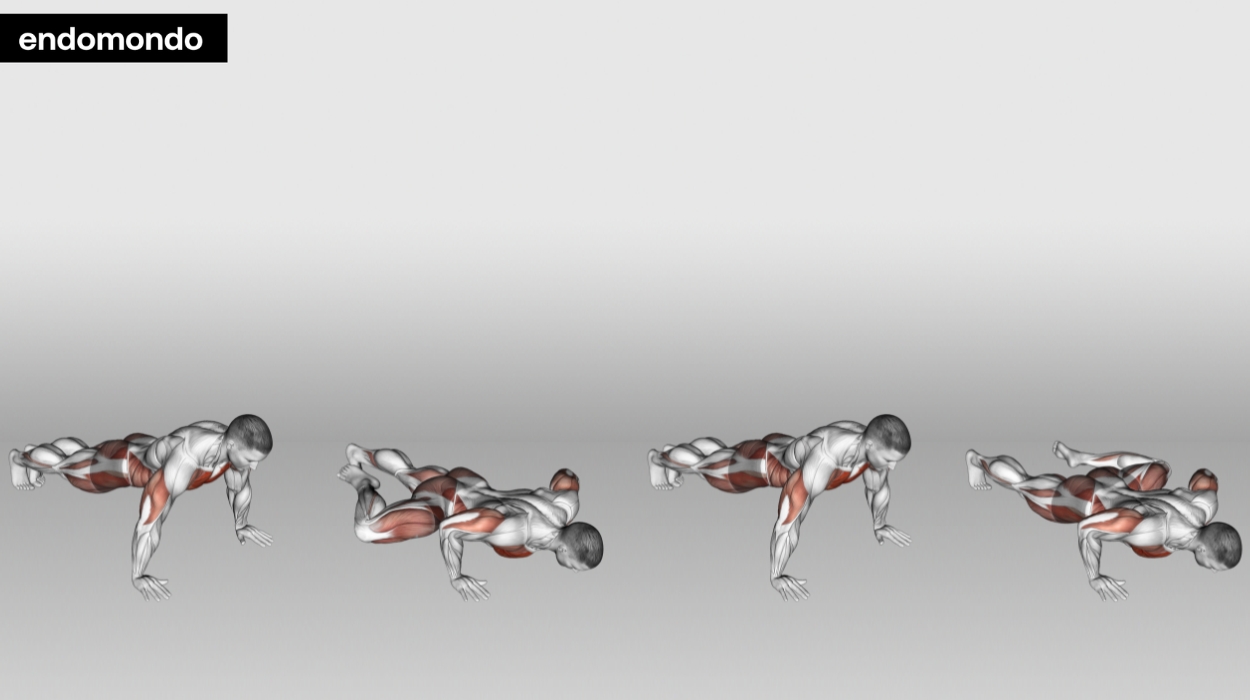
How to do:
- Start in the push-up position with your arms straight, legs straight, and feet on your toes in a straight line on the mat.
- Bring one knee to the side to touch your elbow as you lower yourself.
- Then, push yourself up, straightening your leg.
- As you lower yourself again, bring the other knee to the other elbow.
Tips:
- Ensure your body remains in a straight line throughout the movement.
- Avoid rushing through the exercise to ensure proper muscle engagement.
- Exhale as you push up and bring your knee to your elbow, and inhale as you return to the starting position.
Optimal Sets and Reps: 3 sets of 10 reps.
Dive Bomber Push-Up
The dive bomber push-up is a dynamic bodyweight exercise that primarily targets the chest, shoulders, and triceps while also engaging the back, hips, and core muscles. This exercise promotes chest and shoulder definition and enhances flexibility and mobility in the shoulders and spine while promoting abdominal strength and stability.
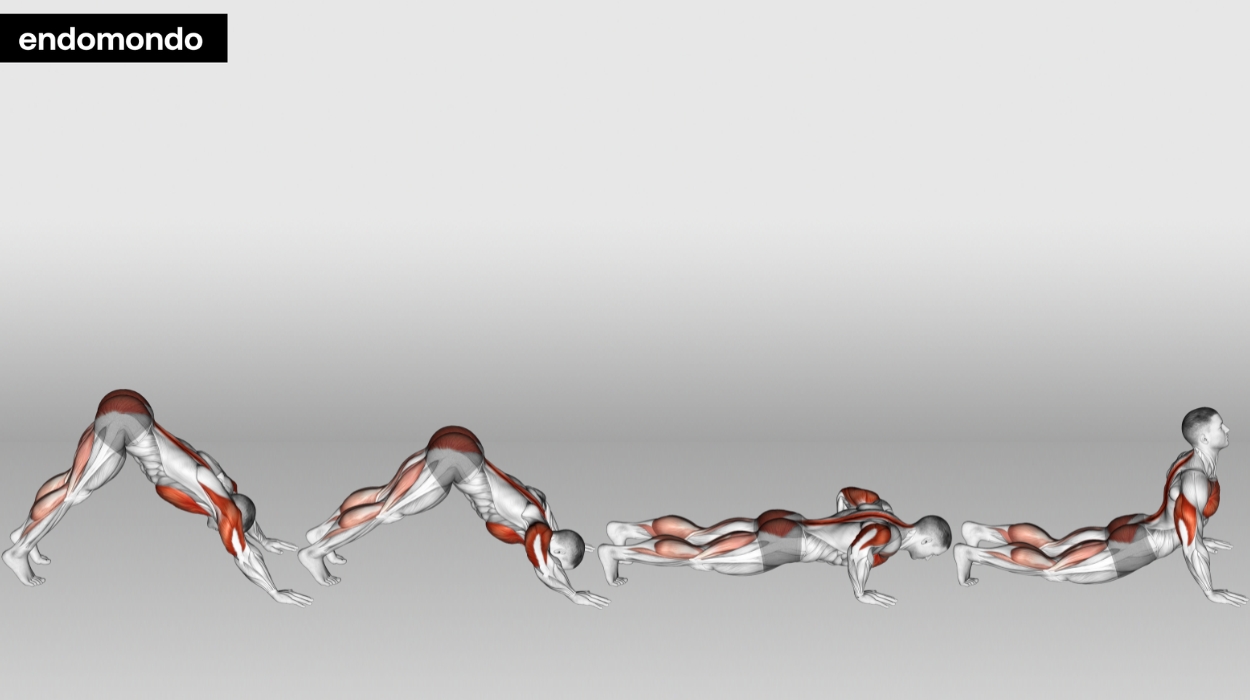
How to do:
- Stand at the edge of your mat, bend forward at the waist, and walk your hands forward until you reach a high plank position.
- Now, lift your hips towards the ceiling, pushing your weight back into your legs until your body forms an inverted V position — also known as the downward dog.
- Then lower your body in an arc, as if you’re going to do a push-up, so your chest almost touches the floor, finishing in an upward dog position.
- Reverse the movement to return to the start.
Tips:
- Avoid excessive arching of the lower back when diving forward, as it can strain your lower back.
- Keep your core muscles engaged throughout the movement to stabilize your body.
- Aim for a full range of motion to engage the target muscles effectively.
Optimal Sets and Reps: 3 sets of 8-10 reps.
Renegade Row
The renegade row is a compound exercise that primarily targets the chest, back, and shoulders while providing a strong engagement of the core and abdominal muscles. This is not an exercise for those with severe muscle imbalances. It helps sculpt and strengthen the chest and back muscles, promoting upper body definition.
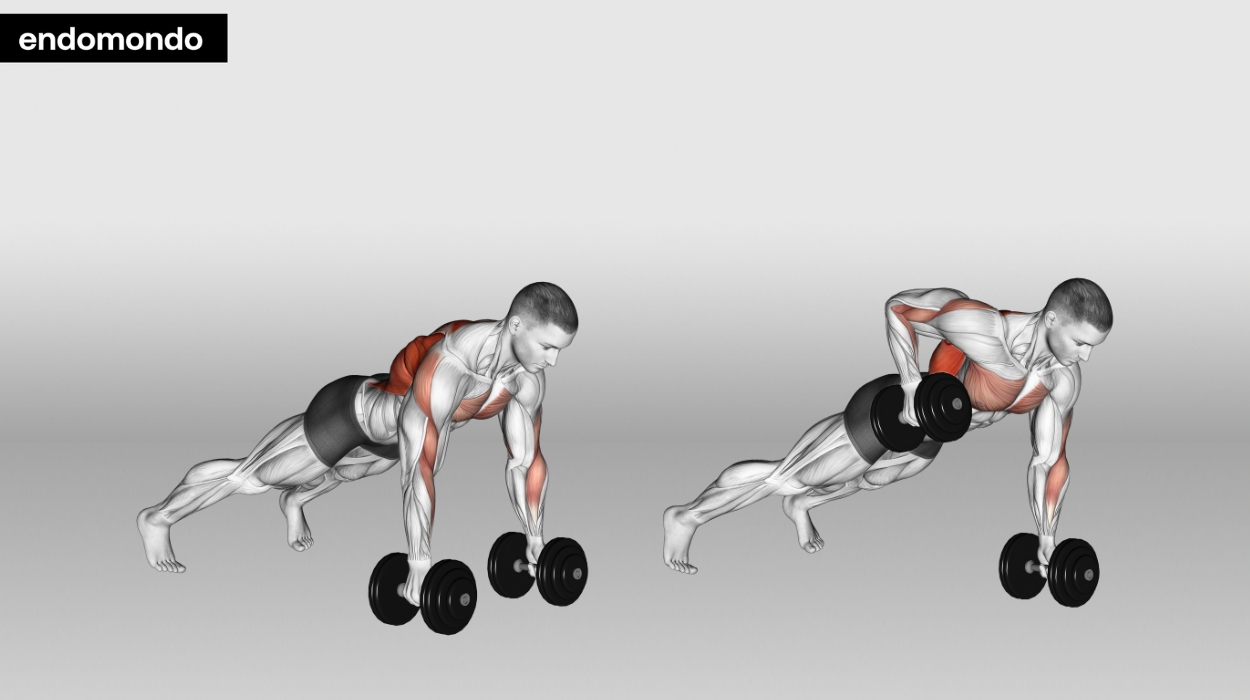
How to do:
- Begin in a plank position with your body straight, arms shoulder-width apart, with a dumbbell in each hand. Start with a light weight until you’ve mastered the movement and are comfortable progressing.
- Perform a push-up, then at the top, row one dumbbell up towards your hip, retracting your shoulder blade and engaging your core to prevent your body from twisting.
- Lower the weight, perform another push-up, and repeat on the other side.
Tips:
- Keep your body in a straight line from head to heels, engaging your core to prevent sagging or arching.
- Avoid jerky or fast movements when rowing the dumbbells
- Exhale as you lift the dumbbell and inhale as you return it to the ground.
Optimal Sets and Reps: 2-4 sets of 4-10 reps.
Anatomy Of The Chest And Abs
The chest and abdominal areas are connected by skin, bones, muscles, tendons, and connective tissue called fascia.[1] The back side of these areas is linked and anchored together by the spinal column and ribs. However. the front area is mostly attached by soft tissue.
Let’s look at the chest and abs in detail to help maximize your workouts.
The Chest
The chest is part of the thorax[2] which is the anatomical region between the base of the neck and the upper edge of the abdomen. It is made up of muscles and bones and encases vital organs such as the heart and lungs. The collarbones or clavicles, ribs, and breastbone or sternum provide the foundation for the pectoralis muscle group and others.
The pectoralis major and minor,[3] the muscles between the ribs, and the serratus anterior [4]are the muscles that comprise the anterior, or front portion of the thorax. The pecs are the largest and most known muscles. The serratus anterior and other muscles are smaller and underneath the pecs but are required for the support and function of the upper body and limbs.
The muscles contained in the thorax perform and support functional movement, stabilization, and pushing activities which is why it is important to strengthen them.
Abdominal Anatomy
The abs consist of multiple layers of muscles that attach at the bottom ribs and top edge of the pelvis. The outermost, or superficial abdominal muscle commonly known as the six-pack is the rectus abdominis. The abdominal region[5] is also supported by the transverse abdominis and internal, and external oblique muscles.
The rectus abdominis performs trunk flexion or bending the trunk forward and flexing the hips. The deeper muscles that lie under the rectus provide trunk and spinal stability during your workouts or everyday life tasks.
How Often Should You Do Chest And Ab Workouts?
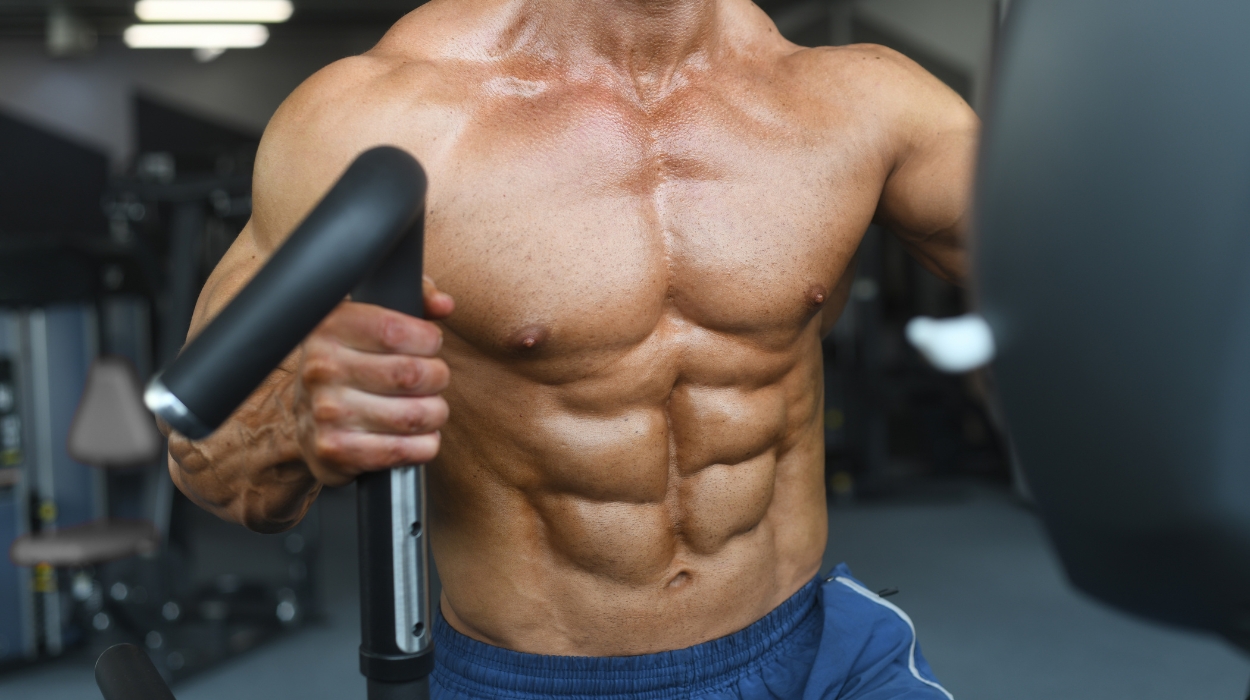
Your workout regimen largely depends on your fitness level, goals, and your body’s ability to recover.
For beginners, two days per week for chest and ab workouts are plenty, or three if you’re more advanced. These exercises are often incorporated into full-body routines, providing a balanced approach to strength training. Exercising without rest promotes small muscle tears.
Allow at least one full day of rest between workouts to enable your muscles to repair and grow.
Remember that rest and recovery are equally important regardless of how often you work out. Overtraining[6] can lead to fatigue, decreased performance, and a higher risk of injury.
Also, nutrition plays a vital role in muscle growth and recovery. Eating a balanced diet that’s rich in protein, healthy fats, and complex carbs can help fuel your workouts and recovery more effectively.
Safety Precautions
As with all forms of physical activity, safety should be paramount when performing your abs and chest workouts. Here are some safety precautions to remember:
Warm-Up And Cool-Down
Start every workout with a warm-up to prepare your muscles and cardiovascular system for the exercise. This can include light cardio or dynamic stretching.
After your workout, take time to cool down with some light stretching or low-intensity cardio. This helps to gradually lower your heart rate and blood pressure, although evidence for their impact on avoiding injuries[7] is still inconclusive.
About 5-10 minutes for a warm-up and cool-down is usually enough.
Use Proper Form
Incorrect form not only decreases the effectiveness of the exercise but can also lead to injuries.
Don’t Rush
It’s quality, not quantity, regarding strength training. Take your time to perform each exercise slowly and with control. This will help to engage your targeted muscles properly and prevent injuries.
Listen To Your Body
Stop if you feel sharp pain during an exercise. Muscle fatigue is normal, but pain can indicate an injury. It’s better to rest and recover than to push through and make a minor injury a major one!
Use Equipment Safely
If you’re using weights or machines, use them safely. Always have a spotter when you’re lifting heavy weights, particularly during exercises such as the bench press.
Stay Hydrated
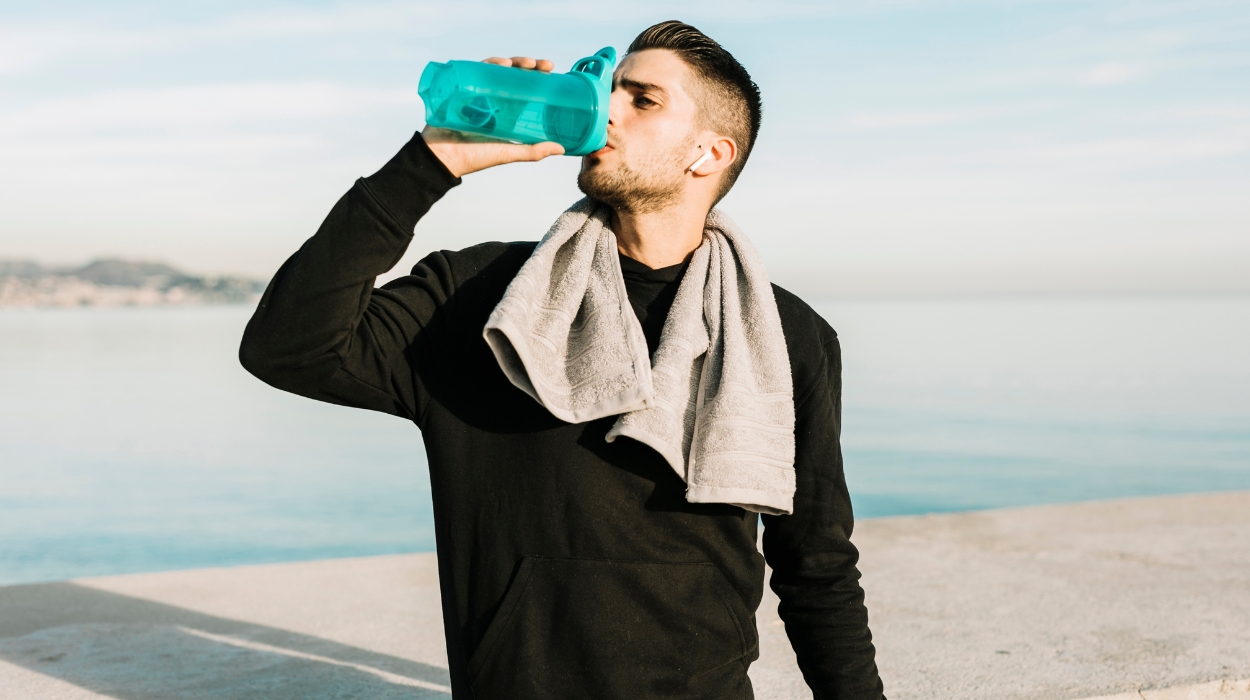
Hydrate before, during, and after your workout. Dehydration can decrease your performance and lead to muscle cramps or dizziness.
Rest And Recover
Allow your muscles time to rest and recover between workouts. Overtraining can lead to fatigue, decreased performance, and injury. Remember, muscles grow during your rest, not during the workout itself!
Following these safety precautions will reduce your risk of injury and make your workouts more effective.
Conclusion
The seven workouts we’ve highlighted are fantastic starting points for building these muscle groups, whether you’re a beginner or a seasoned gym-goer. Achieving strong, sculpted chest and abdominal muscles is more than just an aesthetic goal — it’s about improving your overall fitness, strength, and well-being.
Frequently Asked Questions
Yes, you can train your chest and abs together. These two muscle groups don’t interfere with each other during the workout, making them a good pair to target in the same session.
The fastest way to build any muscle group, including the chest and abs, is through consistent strength training, a protein[8]-rich diet to aid in muscle recovery and growth, and adequate rest. Remember, it’s a process that takes time, and consistency is key.
Absolutely, strength training,[9] including chest and ab workouts, is beneficial for everyone, regardless of gender. Both men and women can gain strength, improve muscle tone, and enhance overall health by incorporating these workouts into their fitness routines.
Resources
- Bordoni (2023). Anatomy, Fascia. [online] Available at: https://pubmed.ncbi.nlm.nih.gov/29630284/.
- Kudzinskas A;Callahan AL (2023). Anatomy, Thorax. [online] Available at: https://pubmed.ncbi.nlm.nih.gov/32491642/.
- Baig MA;Bordoni B (2023). Anatomy, Shoulder and Upper Limb, Pectoral Muscles. [online] Available at: https://pubmed.ncbi.nlm.nih.gov/31424825/.
- K;Lui, L. (2024). Anatomy, Thorax, Serratus Anterior Muscles. [online] Available at: https://pubmed.ncbi.nlm.nih.gov/30285352/.
- Sevensma, K.E., Leavitt, L. and Pihl, K.D. (2023). Anatomy, Abdomen and Pelvis, Rectus Sheath. [online] Nih.gov. Available at: https://www.ncbi.nlm.nih.gov/books/NBK537153/.
- Armstrong, L.E., Bergeron, M.F., Lee, E.C., Mershon, J.E. and Armstrong, E. (2022). Overtraining Syndrome as a Complex Systems Phenomenon. Frontiers in Network Physiology, [online] 1. doi:https://doi.org/10.3389/fnetp.2021.794392.
- Bas Van Hooren and Peake, J.M. (2018). Do We Need a Cool-Down After Exercise? A Narrative Review of the Psychophysiological Effects and the Effects on Performance, Injuries and the Long-Term Adaptive Response. Sports Medicine, [online] 48(7), pp.1575–1595. doi:https://doi.org/10.1007/s40279-018-0916-2.
- Carbone, J.W. and Pasiakos, S.M. (2019). Dietary Protein and Muscle Mass: Translating Science to Application and Health Benefit. Nutrients, [online] 11(5), pp.1136–1136. doi:https://doi.org/10.3390/nu11051136.
- Westcott, W.L. (2012). Resistance Training is Medicine. Current Sports Medicine Reports, [online] 11(4), pp.209–216. doi:https://doi.org/10.1249/jsr.0b013e31825dabb8.




